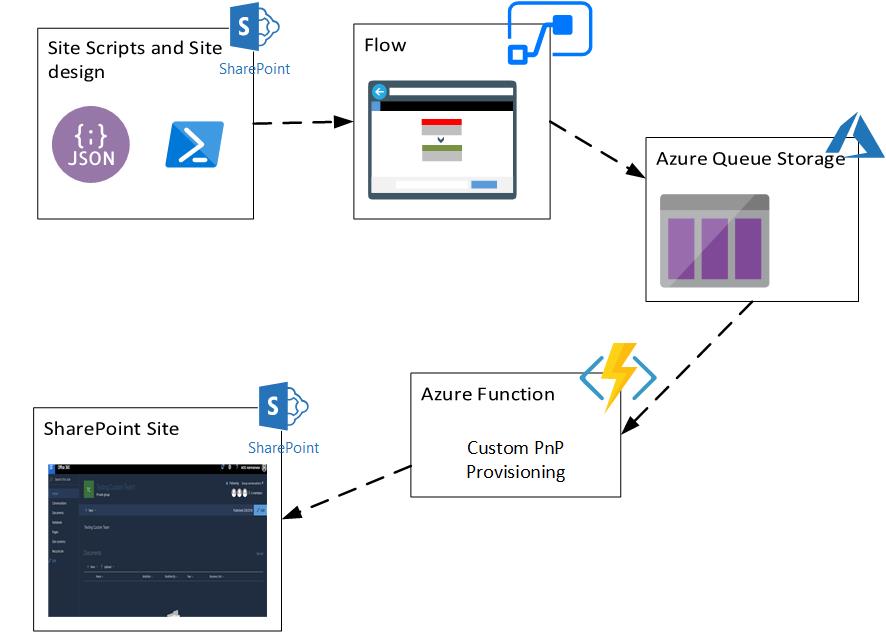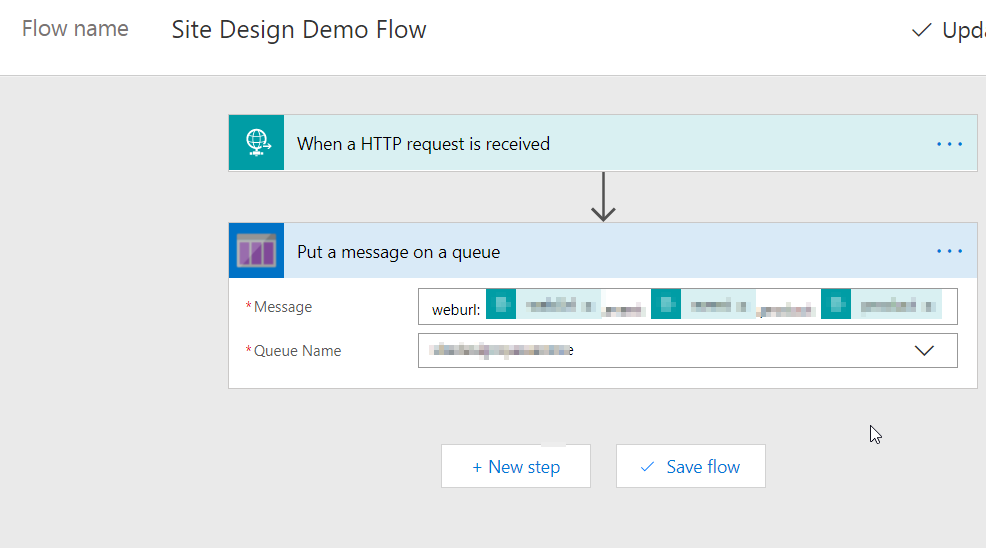
With Site Scripts and Site design, it is possible to invoke custom PnP Provisioning for Modern Team Sites from a Site Script. In the previous blog, we saw how we can provision Simple modern sites using Site Scripts JSON. However, there are some scenarios where we would need a custom provisioning template or process such as listed below:
- Auto deploy custom web components such as SPFx extension apps
- Complex Site Templates which couldn’t be configured
- Complex Document libs, content types that are provided by JSON schema. For an idea of support items using the OOB schema, please check here.
Hence, in this blog, we will see how we can use Flow and Azure Functions to apply more complex templates and customization on SharePoint Modern Sites.
Software Prerequisites:
- Azure Subscription
- Office 365 subscription or MS Flow subscription
- PowerShell 3.0 or above
- SharePoint Online Management Shell
- PnP PowerShell
- Azure Storage Emulator*
- Postman*
* Optional, helpful for Dev and Testing
High Level Overview Steps:
1. Create an Azure Queue Storage Container
2. Create a Microsoft Flow with Request Trigger
3. Put an item into Azure Queue from Flow
4. Create an Azure Function to trigger from the Queue
5. Use the Azure Function to apply the PnP Provisioning template
Detailed Steps:
This can get quite elaborate, so hold on!!
Azure
1. Create an Azure Queue Store.
Note: For dev and testing, you can use the Azure Storage Emulator to emulate the queue requirements. For more details to configure Azure Emulator on your system, please check here.
Microsoft Flow
2. Create a Microsoft Flow with Request trigger and then add the below JSON.
Note: If you have an Office 365 enterprise E3 license, you get a Flow Free Subscription or else you can also register for a trial for this here.
3. Enter a message into the Queue in the Flow using the “Add message to Azure Queue” action.

Note: The flow trigger URL has an access key which allows it to be called from any tenant. For security reasons, please don’t share it with any third parties unless needed.
Custom SharePoint Site Template (PowerShell)
4. Next create a template site for provisioning. Make all the configurations that you will need for the initial implementation. Then create the template using PnPPowerShell, use the PnP Provisioning Command as shown below.
Get-PnPProvisioningTemplate -Out .\TestCustomTeamTemplate.xml -ExcludeHandlers Navigation, ApplicationLifecycleManagement -IncludeNativePublishingFiles
Note: The ExclueHandlers option depends on your requirement, but the configuration in the above command will save a lot of issues which you could potentially encounter while applying the template later. So, use the above as a starting template.
Note: Another quick tip, if you have any custom theme applied on the template site, then the provisioning template doesn’t carry it over. You might have to apply the theme again!
5. Export and save the PowerShell PnP Module to a local drive location. We will use it later in the Azure Function.
powershell Save-Module -Name SharePointPnPPowershellOnline -Path “[Location on your system or Shared drive]”
SharePoint
6. Register an App key and App Secret in https://yourtenant.sharepoint.com/_layouts/appregnew.aspx and provide the below settings.
7. Copy the App Id and Secret which we will use later for Step 9 and 10. Below is a screenshot of the App registration page.
8. Trust the app at https://yourtenant-admin.sharepoint.com/_layouts/appinv.aspx by providing the below xml. Fill in the App Id to get the details of the App.
Azure Function
9. Create a Queue Trigger PowerShell Azure function
10. After the function is created, go to Advance Editor (kudu) and then create a sub folder “SharePointPnPPowerShellOnline” in site -> wwwroot -> [function_name] -> modules. Upload all the files from the saved PowerShell folder in the Step above into this folder.
11. Add the below PowerShell to the Azure Function
12. Test the Function by the below input in PowerShell
$uri = "[the URI you copied in step 14 when creating the flow]"
$body = "{webUrl:'somesiteurl'}"
Invoke-RestMethod -Uri $uri -Method Post -ContentType "application/json" -Body $body
PowerShell and JSON
13. Create a Site Script with the below JSON and add it to a Site Design. For more details, please check the link here for more detailed steps.
14. After the above, you are finally ready to run the provisioning process. Yay!!
But before we finish off, one quick tip is that when you click manual refresh, the changes are not immediately updated on the site. It may take a while, but it will apply.
Conclusion:
In the above blog we saw how we can create Site templates using custom provisioning template by Flow and Azure Function using SharePoint site scripts and design.
